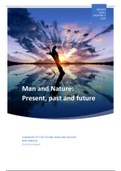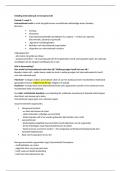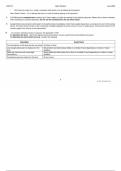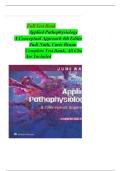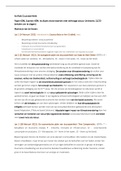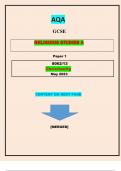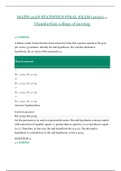YEAR 2
QUARTER 3
2020
Man and Nature:
Present, past and future
SUMMARY OF THE COURSE MAN AND NATURE
NWI-MB023C
ELISE REUVEKAMP
,Inhoud
0 Introduction .......................................................................................................................................... 5
1 Defining key terms................................................................................................................................ 5
2 The state of nature ............................................................................................................................... 5
Causes of nature’s decline................................................................................................................... 6
Turning the tide ................................................................................................................................... 7
Relationships between environmental themes .................................................................................. 7
Living planet index............................................................................................................................... 7
Underlying causes ............................................................................................................................... 9
Mini lectures:....................................................................................................................................... 9
Questions and answers self-study:.................................................................................................... 13
3 Gathering and interpreting data ........................................................................................................ 14
Organization of data gathering ......................................................................................................... 14
Presentation of spatial distribution................................................................................................... 14
Rarity of species ................................................................................................................................ 15
Mapping vs monitoring ..................................................................................................................... 15
Red lists ............................................................................................................................................. 15
Questions and answers self-study..................................................................................................... 16
4 Visions of nature................................................................................................................................. 19
Visions of nature: determining your own position ........................................................................... 19
Images of nature ............................................................................................................................... 21
Conceptual socio-cultural framework ............................................................................................... 21
Images of relationships with nature.................................................................................................. 21
The position of science ...................................................................................................................... 22
Visions of nature: determining your own position 2......................................................................... 24
Visions of nature and nature management ...................................................................................... 25
Questions and answers self-study..................................................................................................... 26
5 References for nature......................................................................................................................... 29
Characterisation references and target images ................................................................................ 29
Types of references ........................................................................................................................... 29
Relationship references – target images ........................................................................................... 30
Historical or palaeoreferences .......................................................................................................... 30
Questions and answers self-study..................................................................................................... 32
6 Methodology – Dating techniques ..................................................................................................... 34
Dating methods: archaeological/historical ....................................................................................... 34
Dating methods: Incremental ........................................................................................................... 35
, Dating methods: Radiometric ........................................................................................................... 35
Chronologies...................................................................................................................................... 36
Questions and answers self-study..................................................................................................... 37
7 Methodology – Gathering historical data archaeology ...................................................................... 39
Species composition .......................................................................................................................... 39
Pre-depositional processes ............................................................................................................... 39
Taphonomic processes ...................................................................................................................... 39
Excavation methodologies ................................................................................................................ 40
Species identification ........................................................................................................................ 41
Reporting ........................................................................................................................................... 41
Interpretation of data........................................................................................................................ 41
Data sources ...................................................................................................................................... 41
Questions and answers self-study:.................................................................................................... 42
8 Methodology – Gathering historical data written sources ............................................................... 44
Primary and secondary sources ........................................................................................................ 44
Source critique/analysis .................................................................................................................... 44
Types of sources ................................................................................................................................ 44
Problems with written sources ......................................................................................................... 45
Written sources and qualitative data ................................................................................................ 45
Written sources and indirect and direct quantitative data............................................................... 45
Source of sources .............................................................................................................................. 45
Questions and answers self-study:.................................................................................................... 46
9 Methodology – Reconstructing the past ............................................................................................ 48
Vegetation reconstruction from pollen............................................................................................. 48
Eutrophication and acidification ....................................................................................................... 48
Climate............................................................................................................................................... 49
Desertification ................................................................................................................................... 49
Fish stocks reconstruction ................................................................................................................. 49
Questions and answers self-study..................................................................................................... 50
10 Geographical genesis........................................................................................................................ 51
Geological time scales ....................................................................................................................... 51
Glacials and interglacials ............................................................................................................... 51
Milankovic cycles ........................................................................................................................... 51
Role of ocean currents .................................................................................................................. 52
Role of albedo................................................................................................................................ 52
Role of volcanos ............................................................................................................................ 52
, Marine isotopes stages.................................................................................................................. 52
Ice caps .............................................................................................................................................. 53
Origination of ice-pushed ridges ................................................................................................... 53
Effects on vegetation..................................................................................................................... 53
Extent of Weichsalian glaciation ................................................................................................... 53
Post-weichselian sea level rise ...................................................................................................... 53
Questions and answers self-study..................................................................................................... 55
11 NW Europe in the Holocene ............................................................................................................. 57
Sea level rise ...................................................................................................................................... 57
Climate development and fluctuations ............................................................................................. 57
Changing river systems...................................................................................................................... 58
Vegetation developments ................................................................................................................. 58
Integrated landscape development in the Netherlands ................................................................... 60
12 Human influences in the Holocene – Earth colonization ................................................................. 64
Mass extinction ................................................................................................................................. 64
Human colonization .......................................................................................................................... 64
Animal colonization ........................................................................................................................... 65
Hypothesis to explain the fast extinctions ........................................................................................ 66
Population history of three species................................................................................................... 66
Viking expansion................................................................................................................................ 66
Questions and answers self-study..................................................................................................... 67
13 Human influences in the Holocene – Domestication and agriculture ............................................. 69
Origin of domestication and agriculture ........................................................................................... 69
Domesticated vs wild species ............................................................................................................ 69
Agricultural developments ................................................................................................................ 70
Questions and answers self-study..................................................................................................... 71
14 Human influences in the Holocene – Columbian exchange ............................................................. 73
Indo-European migrations................................................................................................................. 73
Pre-Columbian America..................................................................................................................... 73
Human population............................................................................................................................. 74
Factors underlying Indo-European dominance ................................................................................. 74
Trading............................................................................................................................................... 75
Questions and answers self-study..................................................................................................... 76
15 Human influences in the Holocene – Anthropocene ....................................................................... 77
What is the Anthropocene? .............................................................................................................. 77
Population growth ............................................................................................................................. 77

